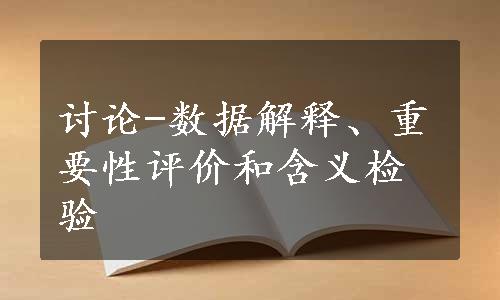
讨论部分针对结果部分中提交的数据,解释相应的发现,评价他们的重要性,检验它们的含义。对于科学写作来说,这是最具有挑战性的部分,并将说明你对结果的理解程度。所以,讨论部分也是一篇论文里最难写的部分。或许大家都知道,许多投稿的论文,其中的数据正确,也很有意义,但最后还是被期刊编辑退稿,原因就在于糟糕的讨论部分。在很多情况下,讨论部分掩盖甚至歪曲了实验数据的意义,当然最后也只能导致投稿被拒。
好的讨论部分应该具备什么特点呢?如果作者在撰写讨论部分时能够注意以下规则,这个问题也就自然有了答案:
1.尽量揭示结果部分说明的原理、关系和普遍性意义。务必牢记的是,讨论部分重在讨论结果而不是重述结果。
2.陈述你是否实现解决研究问题的目标,指出结果部分的特例或无法用关系描述的情况,说明尚未解决的问题,不要试图掩盖或逃避不理想的数据。
3.说明实验结果与分析同文献中的工作一致的地方在哪里、不同的地方在哪里。
4.大胆指出科研工作具有的理论意义和可能的实际应用价值,如果可能的话,对未来的研究方向提出建议。
5.为结论部分的每个论点总结论据。正如资深科学家所说,“不要想当然地设想任何事情。”
6.不要重复在论文其他部分中提供的材料。
材料与方法部分同结果部分相互呼应;同理,引言部分与讨论部分也是如此。引言部分要或明确或含蓄地指出文献未解决的一个或者几个问题;讨论部分应该指出论文的科研结果对解决这一个或几个问题提供了什么帮助。如果在引言部分没有指出待解决的问题,撰写讨论部分时就难度颇大。如果引言部分指出了待解决的问题,撰写讨论部分就要记得对这些问题给出合理解答。
例:
4.Discussion(www.daowen.com)
First objective of the experiment was to evaluate the correspondence between the numerical calculated Ψsoiland observed Ψsoilwith watermark sensors.Second objective was to investigate the sensitivity of the Ψsoil calculation to the implemented root distribution.Both objectives should contribute to a better knowledge of the calculation of Ψsoilpatterns in‘Conference’pear orchards.This should result in more optimal placement of watermark Ψsoil sensors,frequently used for irrigation scheduling in pear orchards.
4.1.Numerical calculation of Ψsoil
Reported measurement variation from the Watermark sensor(Leib et al.,2003;Nolz et al.,2013)lies between 14%and 27%.The overall average Ψsoil observation in this experiment was-32.5 kPa which means that 35-67%of the overall RMSE in this experiment can be allocated to measurement variation from the sensor.Possible sources of the variation inΨsoilcalculation are the variability of soil hydraulic properties,efficiency of rainfall and estimations of crop transpiration.
General accordance between the calculated soil and the observed Ψsoilwas equal to previous similar root water uptake calculations in fruit trees.Gong et al.(2006)calculated root water uptake of a mature apple tree in 2D with the root zone parameterized form root length observations.Calculated soil water distribution in the Ψsoilwas compared to TDR observations of Ψsoil water content.R2ranged between 0.63 and 0.70 for 220 observations.In the present study overall R2between calculated Ψsoiland observedΨsoilwas 0.56 for 1320 observations.Zhou et al.(2007)calculated root water uptake of irrigated grape in 2D with HYDRUS and parameterized the root zone from root length observations.Calculated soil water distribution was compared to soil moisture measurements recorded with FDR probes.RMSE between observed and calculated soil water content ranged between 0.01 and 0.03 cm3/cm3.In the present study RMSE between observedand calculated soil moisture was 0.03 cm3/cm3.
Main drawback of the Ψsoilcalculation was the poor accordance between calculated and observed Ψsoilin the range between 0 and-20 kPa.Just after irrigation events,or heavy rainfall,the observed Ψsoil increased rapidly to 0 kPa while dryer Ψsoilvalues were calculated by HYDRUS.The mismatch between observed and calculated Ψsoilcan be allocated to the inability of the Watermark sensor to measure matrix potentials higher than the air entry pressure of the sensor which is about-10 kPa(Scanlon et al.,2002).The unreliable Ψsoil observation in the wet range just after rainfall and irrigation events has previously been observed in similar conditions(Janssens et al.,2011)and can be explained further by hysteresis in the wetting curve from the sensor and failure in dynamic response after partial rewetting of the soil(McCan et al.,1992;Scanlon et al.,2002).In this wet range the calculated Ψsoilprobably approximates the true Ψsoilbetter.This implicates that sensor placement in the wet range of the soil,with Ψsoilabove-20 kPa,leads to overestimation of Ψsoil.This increases the risk of inaccurate irrigation scheduling,especially when Ψsoilis maintained close to-30 kPa such as e.g.Janssens et al.(2009)which reflects farmers'practices in Belgium.The Ψsoilcalculation in the experiment showed that after irrigationto a rate of 80%ET the wet range of the soil extended to the entire irrigated side of the tree to a depth of 70 cm.
4.2.Sensitivity of the calculation to the selected root distribution
Root length concentrations in the three plots showed a gradual decrease with depth similar to Gong et al.(2006),Besharat et al.(2010),Yao et al.(2011)and others.In the horizontal direction root maximal length densities were observed at 30 and 50 cm distance from the tree trunk.Green and Clothier(1999)showed already for apple that maximal root length concentrations are not necessarily situated close to the trunk.On the contrary root weight concentration,was always higher close to the tree trunk in accordance to coarse root observations in one of the plots.The discrepancy between mass and length of fine roots was previously observed by Oppelt et al.(2005)in tropical fruit tree species.
In the majority of root water uptake studies in fruit trees,the root zone is parameterized based on observed root length distribution(Gong et al.,2006;Green and Clothier,1999;Green et al.,2003;Yao et al.,2011;Zhou et al.,2007).Only Satchithanantham et al.(2014)expressed recently root distribution in terms of weight distribution by discussing the water uptake of potato.Determining fine root length is slightly more time consuming then achieving fine root weight since roots need to be scanned photographically.For two of the three plots(plot A and B)the quality of the numerical calculation was comparable between calculations based on RLD and RWD.However in one of the three plots(plot C)a satisfying calculation of Ψsoil was only possible using RLD to parameterize the root zone.Furthermore mild waterΨstress in this plot,observed by depressed stem and altered sap flux density,could not be reproduced by HYDRUS while parameterizing the root zone using RWD.Likewise RLD could be correlated to Ψsoil observations,similar to observations in olive(Searles et al.,2009),while RWD could not.The relationship between RLD andΨsoil variation was dominated by the observations in the non-irrigated plot C where the highest RLD was observed at the sensors where the lowest Ψsoil was measured.This observation needs to be confirmed by other similar observations but may illustrate how fine root growth is related to water uptake.Previously Green and Clothier(1995)addressed the altered root water uptake patterns in kiwi fruit vine mainly to changes in root distribution.Garré et al.(2011)showed the relation between soil wetting and root growth in a lysimeter.It makes sense that fine root growth is better captured with RLD rather than RWD.
Likewise the calculation of root water uptake using root distributions derived from literature yielded good results in two out of the three plots(plot A and B)it failed in the third plot(plot C).In this case literature root observations were taken from apple orchards(Besharat et al.,2010;Gong et al.,2006)due to the lack of root observations in pear orchards but a similar deficientΨsoil calculation can be expected when using root observations from other pear tree orchards.The present experiment shows how root distributionis tree specific and that it has significant impact on the numerical calculation of Ψsoil.
免责声明:以上内容源自网络,版权归原作者所有,如有侵犯您的原创版权请告知,我们将尽快删除相关内容。





